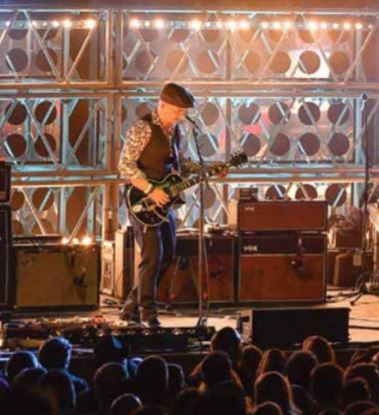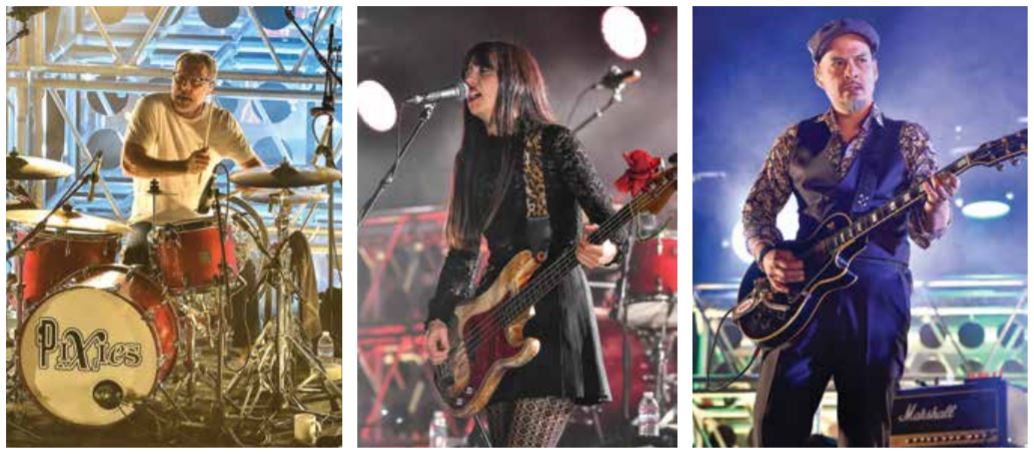
Staying Focused
Both the house and monitor approaches for the Pixies are straightforward and largely unfettered with extras. Wilson ran 24 inputs on the recent tour, while Jones managed 28 outputs, and they worked with venue-provided main reinforcement systems at every stop, carrying consoles, stage and in-ear monitoring, and accessories, provided by Rat Sound Systems (Camarillo, CA). Most of the microphones are from Wilson’s own collection.
Yet while the touring system infrastructure is relatively uncomplicated, the duties of the two engineers are anything but that once the show starts. The Pixies don’t use a set list, and both the songs and their order are different every single time out. The engineers get a radio call about 10 minutes before the band hits the stage to let them know the first song, and then it goes to a potential playlist in excess of 80 possible selections.
While the rest of the band is on in-ear monitors (JH Audio JH16 custom earbuds fed by Sennheiser 2000 Series wireless systems), Black Francis prefers stage wedges. “He was on in-ears as well, but switched back about a year and a half ago,” Jones explains. “He doesn’t want to be in a ‘fishbowl,’ really preferring to engage with the audience. He’s also located as far downstage as he can be without affecting the production, positioned as close to the audience as possible to feel their reaction.”
This interaction helps determine the set list, he continues, adding, “Every show is a journey, any direction is possible given what’s happening on any given night. This is the essence of the live experience, this context of being interactive and truly connected with the audience.”

While both engineers employ digital consoles (Avid VENUE | S6L for Wilson, Yamaha PM5D for Jones), the band’s unique and somewhat unpredictable approach doesn’t lend itself to setting up a lot of presets and snapshots ahead of time. Instead, they’re engaged in every moment throughout a show, at times with trance-like attention.
“Charles has a mic feeding the crew’s and the rest of the band’s in-ear monitors where he’ll call out the next song, but I tried it for a while and really couldn’t get comfortable, so I go without,” Wilson says. “It was too distracting. I prefer honing in on what the band is doing in the moment – the sound, the music, the mix – and focus on that.
“Usually it only takes me a chord or drum hit to determine the song and then quickly get things dialed in for that particular song,” he adds. “This is the way I cut my teeth with this band, and it continues to work well to this day. It’s old school, but that’s the way we like it, and most importantly, it’s very effective.”
Essential Truths
The approach with microphones on stage reflects Wilson’s studio roots merged with an “it starts at the source” sensibility. As previously noted, most of the mics are his own, and because the band remains largely stationary, there are no wireless systems on the rider. Mic selections include Sennheiser MD 421 dynamic cardioids on toms, AKG C414 condensers for overheads, Shure SM57 dynamics on guitar amps, and Shure BETA 58A supercardioid dynamics with a shaped frequency response that helps reject stage noise.
“At Sound City, I had the opportunity to work with some of the best engineers and producers in the world, and these were often the mics they used,” Wilson notes. “Simply, they’re great tools and get the job done. We’ll occasionally try new or different mics, and while they can be good, we typically find that they’re no better than what we’ve already got.”

The guitar amps are originals, not newer models or re-issues. Vocals are delivered by seasoned performers who understand key issues such as mic technique. Drums and bass are straightforward in the hands of highly skilled players. “They’re all quality sources,” Wilson says. “It’s essential that engineers not struggle to make it sound good; everything should already be there between the sources and the mics before you begin getting specific about the mix on a given night.”
The lead vocal and vocal mic set the tone; in other words, it all starts with Black Francis’ vocal intelligibility, making sure that his voice is going to sit in the right place in the mix regardless of levels. And then everything else is built based upon that. The guitar amps can get “screaming loud” at times, so they need to be optimized with care and then kept in balance.
His approach is dictated by the amount of PA that’s on hand for a given show. The starting point is the kick drum, and specifically the transient peaks it generates, which determines what will demand the most of the PA. Once that level is established, he starts working on the vocal, making sure there’s plenty of headroom and a strong, clean vocal without feedback.
“The rhythm section needs to be rocking,” Wilson states. “There’s one thing I can’t stand and that’s when you hear a band that is vocals, drums and guitars but there’s no rhythm section backbone. It might be overpowered by the stage volume, or sometimes guitars and vocals are just too dominant in the mix. This can happen when you don’t have as much PA as you’d like, so sometimes it’s understandable, but it has to be taken into account when building a mix.”
